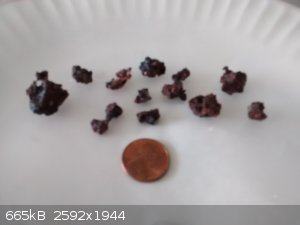While waiting for my copper(I) oxide to filter/settle, I made two more attempts at thermite with anhydrous copper(II) sulfate.
For the first attempt, a charge was made of 160g anhydrous copper(II) sulfate, 20g anhydrous sodium carbonate, and 25g aluminum powder. A larger
charge was used than the previous attempt in the hopes of melting and coalescing any copper formed. Sodium carbonate was used in place of sodium
sulfate to encourage the formation of water-soluble sodium aluminate, instead of aluminum oxide, should the reaction reach the temperatures needed to
decompose the aluminum sulfate to the oxide.
This mixture was packed into a thick-walled paper tube, atop a layer of activated charcoal powder, both intended to prevent the formation of silicate
slag. This, in turn, is surrounded by bentonite granules, to contain the heat of the reaction. This was ignited with potassium permanganate and
glycerin, which as you can see, almost didn't ignite the main charge.
<iframe sandbox width="280" height="160" src="//www.youtube.com/embed/URntp_jVVn8?rel=0" frameborder="0" allowfullscreen></iframe>
This mixture, once ignited, burned slowly and (somewhat) steadily, but unfortunately, didn't get hot enough to melt and coalesce the copper.
Additionally, the paper tube wasn't enough to prevent the inclusion of bentonite granules into the hot slag, the result being a slag very similar to
that produced by the first reaction.
Another attempt was then made, using 68g anhydrous copper(II) sulfate (my remaining stock), 20g aluminum powder, 5g sodium carbonate, and 17 grams
sulfur.
The additional aluminum and sulfur was intended as a 'heat booster', and also allowed the mixture to be more easily ignited. This was placed in a
small glass jar, with some charcoal granules in the bottom, embedded in loose bentonite granules, and ignited with potassium permanganate and
glycerin:
<iframe sandbox width="280" height="160" src="//www.youtube.com/embed/pDeg127YmPQ?rel=0" frameborder="0" allowfullscreen></iframe>
This mixture ignited easily, and burned very steadily with more heat and light than the previous mixtures. The slag, when added to water, produced
much more hydrogen sulfide than the previous mixtures (predictably). The slag was soaked overnight in a solution of a sodium percarbonate based
cleaner, to neutralize acid and hydrogen sulfide, and dissolve any soluble components of the slag. This produced mainly a dense, compact piece of
slag, otherwise similar to the others.
However, on breaking apart, it turned out to be mostly copper, more than in previous attempts. Alas, still no shiny globules, but it's a step in the
right direction.

My next attempt will be blogfast's cuprous oxide thermite. My copper(I) oxide is still settling, after which it will need to be washed and dried (in a
desiccator(?)), so it may be a while.
|